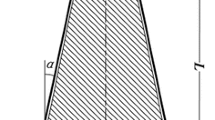Conclusion
On the basis of pressure measurements and frame photography, we examined breakup of a dry foam in shock waves with MS<1.4.
It was established, that in a polyhedral dry foam a wave forms with 1) a leading pressure jump, which propagates through gas phase, and 2) a relaxation zone of pressure increase to a maximum level. The shockwave propagation process is accompanied by breakup of the foam structure.
The initial stage of foam breakup is related to the deformation of the foam cells, their displacement in the direction of wave motion, and breakup of the cell walls. Subsequent break-up of the cell edges and the formation of a gas-droplet suspension follows a mechanism analogous to the stripping of the surface layer of a droplet by gas flow around it. Measured induction times and droplet breakup times are in satisfactory agreement with values calculated from formulas for droplets, if the radius of curvature of the cell edge is taken as the characteristic dimension.
The breakup of foam cells is the initial stage of the interaction of the shock wave with the foam. The formation of a gas-droplet medium and energy transfer between the droplecs and the flow ends much later under the conditions investigated and can take from 300 to 600 usec.
The authors thank B. I. Palamarchuk and B. E. Gel'fand for useful discussions and constructive comments on the contents of this work.
Similar content being viewed by others
Literature Cited
B. I. Palamarchuk, V. A. Vakhnenko, and A. V. Cherkashin, “Air shock waves in explosive welding and cutting and methods to localize them,” Avtomat. Svarka, No. 2, 33 (1988).
A. T. Malakhov and B. I. Palamarchuk, “Reflection of shock waves in gas—liquid foams,” Prikl. Mekh. Tekh. Fiz., No. 1, 106 (1985).
N. M. Kuznetsov, V. I. Timofeev, and A. V. Gubanov, “Analysis of shockwave propagation in a foam at thermodynamic equilibrium,” Fiz. Goren. Vzryva,22, No. 5, 126 (1986).
S. A. Zhdan, “Numerical modeling of the detonation of an explosive charge in foam,” Fiz. Goren. Vzryva,26, No. 2, 103 (1990).
J. S. Krasinski, A. Khosla, and V. Ramesh, “Dispersion of shock waves in liquid foams of high dryness fraction,” Arch. Mech. (Warsaw),30, Nos. 4–5, 461 (1978).
A. B. Britan, I. N. Zinovik, and V. A. Levin, “Propagation of shock waves in a vertical layer of foam with a density gradient,” Prikl. Mekh. Tekh. Fiz., No. 2 (1992).
D. G. Ober, E. M. Kreinik, and P. B. Rend, “Application of foams,” in: V Mire Naukt, No. 7 (1986), p. 36.
A. I. Ivandaev, A. G. Kutushev, and R. I. Nigmatulin, “Gasdynamics of multiphase media. Shock and detonation waves in gas suspension,” Itogi Nauki Tekhniki. Ser. Mekh. Zhidk. Gaza,16, 209 (1981).
P. M. Weaver and N. H. Pratt, “An experimental investigation of the mechanisms of shock-wave-aqueous foam interaction,” in: Proc. 15th International Symposium of Shock Tubes and Shock Waves, Stanford (1985), p. 363.
V. E. Nakoryakov, B. G. Pokusaev, and I. R. Shreiber, Wave Dynamics of Gaseous and Vapor-Liquid Media [in Russian], Energoatomizdat, Moscow (1990).
L. L. Kuznetsova and P. M. Kruglyakov, “Determination of the dispersion of foams on the basis of pressure measurements in Gibbs Plateau channels,” Kolloidn. Zh.,41, No. 4, 673 (1979).
B. E. Gel'fand, S. A. Gubin, and S. M. Kogarko, “Differences in the breakup of droplets in shock waves and their characteristics,” Inzh.-Fiz. Zh.,27, No. 1, 119 (1974).
B. E. Gel'fand, S. A. Gubin, S. I. Timofeev, et al., “Breakup of assemblies of liquid droplets in shock waves,” Prikl. Mekh. Tekh. Fiz., No. 6, 43 (1978).
A. A. Borisov, B. E. Gel'fand, M. S. Natanzon, et al., “On conditions for the breakup of droplets and criteria for their existence,” Inzh.-Fiz. Zh.,40, No. 1, 64 (1981).
Additional information
Moscow. Translated from Fizika Goreniya i Vzryva, Vol. 28, No. 5, pp. 108–116, September–October, 1992.
Rights and permissions
About this article
Cite this article
Britan, A.B., Zinovik, I.N. & Levin, V.A. Breaking up foam with shock waves. Combust Explos Shock Waves 28, 550–557 (1992). https://doi.org/10.1007/BF00755733
Received:
Revised:
Issue Date:
DOI: https://doi.org/10.1007/BF00755733




